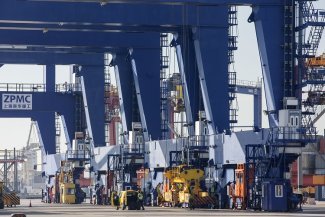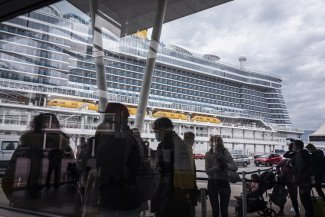With approximately 80 per cent of all goods transported by sea, the industry is looking to find viable solutions whilst sustaining global trade.
Pressure is mounting on the maritime sector to reduce its environmental impact. But the road is not without its hurdles, from the economic and political to the technological. With approximately 80 per cent of all goods transported by sea, the industry is looking to find viable solutions whilst sustaining global trade.
“Our industry is no longer asking ‘if’ or ‘when’ decarbonisation should take place. We know we must act now, and many of us are. The question that remains is ‘how’ the maritime industry will bring about meaningful change during this crucial decade of action,” says Nick Brown, chief executive of Lloyd’s Register, a global services company best known for its work in the maritime sector. The shipping industry emits around 940 million tonnes of CO2 a year, which represents at least 2.5 per cent of all global emissions.
The International Maritime Organization (IMO), the UN agency that regulates the shipping industry, has set itself the target of cutting the sector’s carbon emissions by half (at the least) by 2050, compared to 2008 levels. One way to help meet this target is to have zero-emission vessels as part of the world’s fleet by 2030.
If immediate action is not taken, the IMO warns that, by 2050, emissions from the shipping industry could be 30 per cent higher than they were in 2008. “Most of the industry is capable of meeting these targets,” Lucy Gilliam, senior shipping policy officer for Seas at Risk, tells Equal Times. For Gilliam, the measure “lacks ambition” and amounts to little more than “business as usual”.
“The technologies are already available for the industry to cut emissions more drastically,” says the expert, who feels that stronger regulation is required, alongside the introduction of clean fuels.
According to the estimates of the Global Maritime Forum, investments of $0.8 to $1.2 trillion (€0.7 to €1.05 trillion) are needed to at least halve carbon emissions from shipping by 2050. The type of investments required range from modifications to ships (engines, on-board storage and ship- based energy efficiency technologies), fuel production, on-land storage and bunkering infrastructure.
What kind of fuel to use?
The technologies needed to produce these fuels and zero-emission vessels are almost market ready. The good news is that pilots and demonstrations of zero-emission vessels using different fuels are already underway. The not-so-good news is that, for now, none of the technology is as available on a large scale, so flexibility is key.
Some shipping companies are starting to place all their bets on specific fuels, without any certainty about what the final solution will be. But they are nonetheless ready to gamble on what they hope will open the way to new investments. The world’s leading shipping line, Maersk, announced in January that it will replace its oldest container ships (12 in total) with a carbon neutral methanol-fuelled vessels, to be deployed in 2024. The expected annual savings in carbon emissions are around one million tonnes (bearing in mind that in 2020, for example, Maersk emitted 33 million tonnes of CO2). Methanol is still in the development stage and is a more expensive fuel. But for Maersk, it is feasible in terms of costs, as its customers, such as Amazon, Unilever or H&M, are willing to pay a premium for green fuels in their supply chains.
Methanol can be produced from a variety of renewable sources, such as biomass or electrolysis generated by renewable energy, but there is no certainty as yet whether it will be available in sufficient quantities. World production is currently around 110 million metric tonnes a year and Maersk alone will need 450,000 tonnes to fuel its twelve new ships.
Another option is ‘green’ ammonia produced using hydrogen from water electrolysis. “Ammonia has the potential to be a very convenient and viable alternative fuel for use across a range of applications. One cubic meter of liquid ammonia actually provides approximately 50 per cent more energy than the same volume of liquid hydrogen,” Thanos Sofios, managing partner of commodity trading advisory firm Breakwave Advisors, tells Equal Times. The downside is that it is highly toxic (due to its corrosiveness), which raises environmental and safety concerns for the workers. “Ammonia is best suited for use in cargo ships or other vessels without passengers, and operated by professional crews,” explains Sofios.
Liquid hydrogen is another option, as it can be generated from renewable energy, either solar or wind power, although the primary source is still natural gas. The world’s first liquid hydrogen ship set sail from Australia for Japan on 28 January, and many more of its kind are expected to follow. The EU’s 2020 Hydrogen Strategy, for example, has set a target of producing a million tonnes of clean hydrogen by 2024. But, once again, it has its downsides. “The main one is that it is difficult to store and takes up a lot of space on board, eight times more than fossil fuels, and therefore requires very heavy tanks,” says Sofios.
In the short to medium term, synthetic fuels and biofuels are ahead of the game because they are already widely available and have very low sulphur levels. And liquefied natural gas, natural gas processed for transport in liquid form, will also remain an option until further notice, as it meets IMO regulations.
Biodiesel, a liquid biofuel produced from vegetable oils such as soybean, palm or rapeseed oil, is also a popular option. But it is not likely to be the ultimate solution, as it also has its flip side. Dedicating millions of hectares to fuel crops brings with it the risk of deforestation and volatility in the price of basic foodstuffs.
For the time being, the various options will co-exist. “There will not and should not be a one-size-fits-all approach; different fuels will be tailored to the needs of each segment,” says Ingrid A. Irigoyen, director of the Aspen Institute Shipping Decarbonization Initiative. “That being said, we should anticipate that a limited number of solutions will lead the way based on what we consider key criteria: their zero-emission life cycle potential, scalability and cost.”
It all adds up: from sailboats to green corridors
Aside from fuels, there are other alternatives that can play a key role in emissions reduction. Electric vessels, for instance, are already available for short journeys, although they occupy a modest place in global freight transport for now, as distances are often long and loads heavy.
The industry is above all looking back, back to an old friend: the wind. “Wind assistance is the most direct way to use renewable energy on ships and this resource will play an increasingly significant role in the transition,” Tristan Smith, a shipping specialist and reader at University College London, tells Equal Times. Modern sails, which are more like aircraft wings, can save up to 30 per cent of fuel, for example, when adapted to cargo ships. Agribusiness giant Cargill has already committed to installing them this year.
And, in the meantime, alliances are emerging to speed up the transition. At the COP26 Climate Change Conference in Glasgow in 2021, a coalition of 22 countries agreed to create zero-emission maritime trade routes between ports on specific routes. The idea is to try to coordinate infrastructures and technologies on a more manageable scale. To achieve this, ports may adopt specific regulations, restrict access to vessels using green fuels and offer shipping companies positive incentives (fiscal and other) to choose these routes.
One corridor that could be tested, according to the Global Maritime Forum, is the Asia-Europa container route, the most polluting in the world.
“The first green corridors have the potential to speed up the transition and foster the much-needed public-private sector collaboration when it comes to creating favourable conditions and showing countries how to scale these fuels all around the world,” explains Irigoyen
.
One corridor that has just been confirmed is that linking the ports of Los Angeles and Shanghai, following an agreement reached at the end of January between the cities and ports of Los Angeles and Shanghai, and leading partners in the industry.
Designating reduced speed zones is another option, as well as improving cargo infrastructure at ports. “Bunkering infrastructure development is critical, and the challenges in getting fuel to ships should not be underestimated,” Matthew Williams, Lloyd’s Register decarbonisation strategy manager, tells Equal Times. But if one thing is clear, it is that none of these actions alone will suffice to meet the challenges ahead. “It’s time to put theory into practice. Collaboration between stakeholders from across the shipping value chain is crucial to ensuring the industry can navigate the energy transition safely and sustainably,” concludes Williams.













